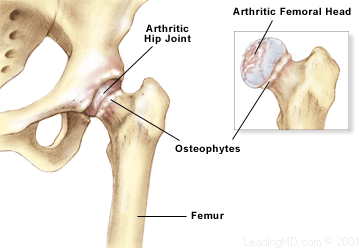







How
is Hip Arthritis Diagnosed?
Hip arthritis can be diagnosed with a history of progressively increasing
pain, first occurring with activities and eventually occurring at
rest. Loss of motion in the hip also may be an indication of hip arthritis.
Progressive limp and limb length inequality may be present as well.
Hip arthritis should be clearly differentiated from other conditions
that result in increasing pain such as hernias, aneurysms, and urologic
and gynecologic problems.
Physical examination
The physician will check:
Difficulty in lifting the leg to the side
may be present in severe cases. The hallmark of hip arthritis is pain
with hip flexion and internal and external rotation. Another common
symptom of hip arthritis is pain in the groin and on the outside thigh.
It is important to examine the lumbar spine for signs of herniated
discs or radioulopathy since these conditions have symptoms
similar to those of hip arthritis. Weakness in the leg, loss of
sensation, reflex uneveness, pain with lumbar motion, or tenderness
over the sacroiliac joint may all be signs that the hip complaints
come from a condition in the back.
Diagnostic tests
Routine X-rays showing a standing front and rear view of the pelvis,
and a "frogleg" lateral view will reveal arthritis signs
such as:
Occasionally, oblique views of the pelvis
are necessary to determine subtle dysplasia (abnormal
tilt in the acetabulum) or abnormal formation of the acetabulum. MRI
scanning and bone scanning may be used to detect other conditions
such as the early stages of osteonecrosis of the femoral
head.
![]()
![]()